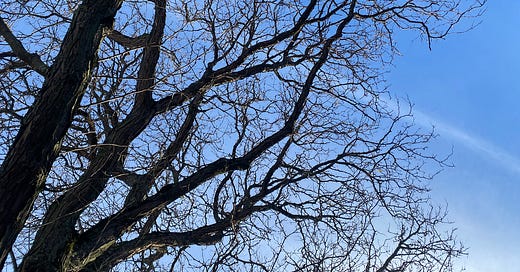This morning, the first snow of the season fell in Boston.
Wet clumps fell at a soft angle outside my window while I conducted a Zoom interview. By the end of my forty-minute call, the flakes had become a drizzling rain.
The sky had dried to a white sheet when I left the house later, but the pavement on my street was newly fertile.
Maple roots ripple underneath the sidewalks, silhouetted like legs under bedsheets. Browning leaves marinate in puddles, and miniature tributaries have carved tunnels through the asphalt. Within the first few steps, my white sneakers deepen to a new shade of grey.
And yet, Massachusetts is in a severe drought.
After an unusually dry fall, most of the state is 8 to 11 inches short of their usual rainfall. Brush fires dotted the state all season— more than 400 in the first three weeks of November, WBZ News reported. Beginning November 20th in Great Barrington, the Butternut Fire charred over 1,600 acres before it could be contained.
Over a hundred miles away, in Cambridge, I had no idea.
I was thinking about how I needed to replace my windshield wipers, while driving through pouring rain to a Friendsgiving dinner. The wipers streaked and blurred across my windshield, distorting the road. Boston drivers, notoriously crazy, are even worse in the rain, I thought.
It rained overnight and all the next day, then again later that week.
Did these deluges reverse the state’s drought status? They did not.
Our rain deficit heading into the winter is significant. According to the U.S. Drought Monitor this week, about 70% of Massachusetts is still at Drought Level 2 (severe drought), while another 15% or so — an area that includes Boston — is labelled Drought Level 3 (extreme).
And so, the Massachusetts drought continues to fuel intense cognitive dissonance for me.
How can we be in a drought, when my raincoat hangs right next to the door, the hood already cinched to match the diameter of my skull? Has the spell not been lifted? The jealous curse broken?
This is how droughts end in the movies: A single drop falls from an expansive sky, then another. The protagonist tilts their head to the clouds in awe as the pitter patter swells. Residents stumble out of their dusty homes, fall to their knees in the mud. Wry grins spread across faces. It is over.
By turns purging then renewing, rain carries a sort of biblical promise. The aftermath of rain has always felt to me like the relief following a good cry. There’s this catharsis, this undoing, this rupture — like the weight of water has become too heavy, fallen, and finally, finally the sky has a lighter burden to bear. Petrichor is the scent of “all is well.”
When it rains, it’s as though, in an instant, the entire arid past has been erased. There is only the new, damp, earth.
Our memory of drought is fleeting.
There is the rub: drought is far more about the past than the present.
Rain seems like a panacea, but drought is a progressive sickness, wounding plants and soil more deeply than a single rainfall restitutes. And I wonder what this means for my understanding of climate change.
We’ve been in a climate crisis my entire life. More specifically, though, we’ve been in a climate crisis since 2010, when we recovered from the recession and could pay attention to any other existential threat.
I know that things are getting worse, that El Niño and La Niña cycles are more volatile, that hurricanes are mounting, and that derechos shouldn’t be this common. I write about climate change for a living.
But I don’t often feel that things are worse. Like, under my shoes, on my skin, in my tactile experience of weather — I’m not clocking the changes. Each day I rediscover weather. The sun is always a balm, and rain is always an exhale.
There’s a disconnect between my momentary experience of climate events and the long-term reality of change. I don’t take the long view.
I am like the frog in a pot of water, slowly boiling without realizing it.



